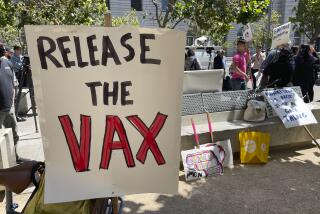What We Need Is a Fear Vaccine
- Share via
President Bush plans to announce today the government’s program to implement a smallpox vaccination program within weeks, starting with half a million military personnel and another half a million health-care and emergency workers, then expanding the program in early 2004 to offer immunization to the entire American public.
Officials estimate that at least 10 million doses will need to be created just to handle all public and private health, medical, police, fire and other emergency personnel. Millions more doses would have to be created if a majority of the public volunteered for the program.
Hold on just a moment. When was all of this decided? Did I miss the public debate after being abducted by aliens? Smallpox was eradicated by 1980. What’s going on here?
Terrorism, that’s what. Or, more precisely, the fear of terrorism. That fear, in fact, has been in the driver’s seat since 9/11. A single shoe-bomb incident means we now all get to disrobe our feet in front of airport strangers.
Smallpox, it seems, would make a horrific weapon of mass destruction for terrorists. Between 1880 and 1980, it killed about half a billion people -- more than all the deaths in the two world wars combined.
So, yes, smallpox could be employed by Iraqi or Al Qaeda operatives against Americans. Then again, they could also use anthrax, or half a dozen other biological weapons. They could go with chemical weapons, even nuclear weapons. Heck, fertilizer in a cargo truck is pretty effective at razing a building.
How did our government decide which of the literally dozens of potential terrorist weapons should be targeted for protection? Given limited time and resources, are we really sure this is the most likely weapon to be used against us?
We must bear in mind that the vaccination process is not without some risk.
The smallpox vaccine is made from its weak biological cousin, cowpox. When you are vaccinated with the weaker virus, your body develops an immunity to the stronger smallpox virus. So, in essence, you are purposefully making yourself slightly sick so that you do not later become deadly sick.
Unfortunately, the system is not foolproof.
Estimates of the number of people who would become ill or die from the vaccination vary. According to the Centers for Disease Control, 74 people would suffer serious complications and one would die for every 1 million vaccinations given. Of the 130 million Americans never vaccinated, about 2,000 would face life-threatening complications, and between 125 and 250 would die. For the 158 million Americans who may need revaccination, about 800 would face the threat of dying, with about 40 succumbing.
These are not trivial casualty statistics -- although when compared to the roughly 30% death rate of a smallpox epidemic, vaccination may seem well worth the risk.
What we do not know -- or, at least, we have not been given the data by our government -- is the degree of likelihood that terrorists would or could use smallpox as a weapon.
When told by experts and government authorities that we are supposed to fear something, the natural human reaction is to believe them. But what is worrisome is what we are not being told to fear, or that we are being told to fear the wrong thing.
This is not a new problem. In 5 BC, the citizens of the Sicilian city of Camarina were told by their leaders that they were being threatened by a pestilence festering in a nearby marsh. The city officials carried out plans to drain the marsh and rid the public of the newly discovered fear. The plague epidemic never hit, and the citizens were grateful. Except now their enemies, the Syracusans, who lived on the other side of the protective marsh, could waltz across the drained land and conquer the Camarinas -- which they promptly did.
Until we think through more carefully which threats are real and which are not, skepticism of the government’s program is a healthy response.
Don’t drain the marsh until we know this is the best course of action.
More to Read
Sign up for Essential California
The most important California stories and recommendations in your inbox every morning.
You may occasionally receive promotional content from the Los Angeles Times.










